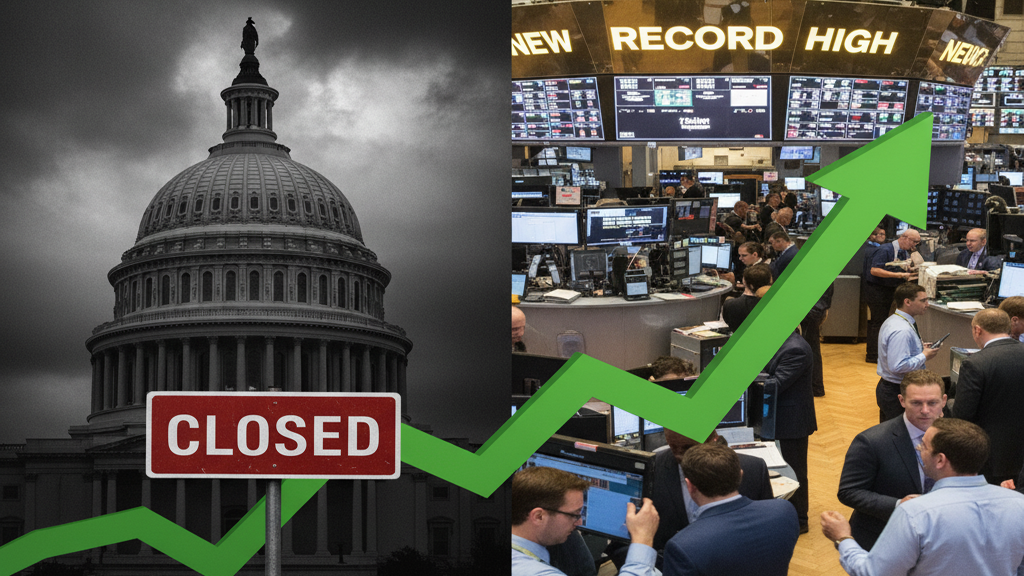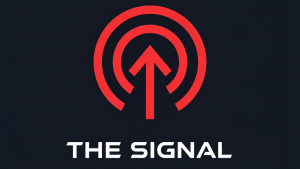The Closing Bell – October 1, 2025
Summary (TL;DR)
For investors, the key takeaway from today’s market action is the deepening disconnect between a relentless stock market rally and new, cautionary economic data. Despite the U.S. government entering a shutdown and a surprisingly weak private-sector jobs report, the major indices the S&P 500, Dow Jones, and Nasdaq Composite all closed higher, with the S&P 500 and Dow hitting new all-time records.
This suggests the market is currently prioritizing the prospect of continued Federal Reserve interest rate cuts, viewing the weaker job and manufacturing data as necessary conditions for the Fed to ease monetary policy. However, this bullish posture is a bet against the immediate economic reality, making the market highly sensitive to any future data that might challenge the rate-cut narrative.
What Happened?
On Wednesday, October 1, 2025, U.S. stock markets closed higher, extending a multi-day winning streak despite a significant U.S. government shutdown that began just after midnight. The S&P 500, Dow Jones Industrial Average, and Nasdaq Composite all finished in positive territory, with the S&P 500 and Dow setting fresh all-time record highs. This upward movement was driven largely by the bond market’s reaction to two key pieces of economic data: a weaker-than-expected private payroll report and a soft manufacturing report.
The ADP Research National Employment Report indicated that the private sector unexpectedly shed 32,000 jobs in September, a stark contrast to expectations for a modest gain. This weak job data, along with a report showing U.S. manufacturing was weaker than anticipated, caused Treasury yields to drop, as traders firmed up their expectations for continued interest rate cuts from the Federal Reserve. The market’s interpretation was that a cooling economy provides the central bank with the necessary justification to loosen policy.
Why It Matters?
The most significant event was the release of the private payroll data, which missed expectations by a wide margin, showing a loss of jobs rather than a gain. Coming into the day, Wall Street had been hoping for a “Goldilocks” scenario, a job market slowing just enough to keep inflation in check and prompt Fed rate cuts, but not so much as to signal a recession. The actual report was weaker than the hoped-for slowdown.
It matters because this weak data, paired with the government shutdown, has cemented investor confidence in continued rate cuts. The market is effectively betting that the weak economic data is good news because it forces the Fed’s hand. Treasury yields, which move inversely to prices, sank because falling yields reflect increased demand for bonds, typically driven by expectations of lower future interest rates. Adding to the significance, the federal government shutdown has delayed the official, more comprehensive jobs report (Non-Farm Payrolls) originally scheduled for Friday, leaving the market to operate solely on the weaker ADP and manufacturing data for the immediate future.
The Debate (The Bull vs. Bear Case)

The Bull Case (The Optimistic View): On one hand, optimists believe this confluence of weak economic data and a political impasse simply accelerates the trajectory for monetary easing. Analysts at High Frequency Economics suggested that while the job report’s accuracy may be debatable, “people in the markets believe that it signals something,” and that signal is a clear path for the Federal Reserve to cut its benchmark rate further, which lowers borrowing costs for companies and consumers.
A report from Morningstar highlights that the S&P 500 has continued its “unrelenting rally” and that the market is “overlooking concerns” like the government shutdown, a historical pattern that often sees markets recovering quickly after a resolution. The core belief is that the market’s current momentum, driven by AI enthusiasm and the rate-cut outlook, is powerful enough to look past short-term economic turbulence.

The Bear Case (The Cautious View): On the other hand, cautious voices point to the growing risk of the economy slowing too much—a signal of a potential recession. The unexpected loss of 32,000 private sector jobs, coupled with a downward revision to the prior month’s data, is not just a slowdown but a potential contraction in employment, which could lead to lower consumer confidence and a sharp slowdown in consumer spending.
Furthermore, reports from the Institute for Supply Management (ISM) indicated that manufacturing was weaker than expected, with some manufacturers citing pain from tariffs. This suggests underlying structural pressures on the economy. Analysts cited in The Washington Post caution that the market’s gains are overlaying a “mixed economic picture” and that a market rally driven almost entirely by the anticipation of rate cuts is vulnerable to a sharp correction if upcoming data suggests inflation is still too sticky, or if the economic slowdown turns into a full-blown recession.
By the Numbers (Key Data & Metrics)
- S&P 500 Close: 6,711.20 (Up 0.3%)
Sets new all-time high. - Dow Jones Industrial Average Close: 46,441.10 (Up 0.1%)
Sets new all-time high. - Nasdaq Composite Close: 22,755.16 (Up 0.4%)
- ADP Private Payrolls (September): −32,000 (Loss of 32,000 jobs)
Significantly missed economist expectations for a gain. - US Manufacturing Data: Weaker than expected
(Indicates factory activity is contracting or slowing down).
Disclaimer: This article is for informational purposes only and does not constitute financial, investment, or legal advice. The information provided is a synthesis of publicly available data and expert analysis and should not be considered a recommendation to buy or sell any security. Investing in the stock market involves risk, including the possible loss of principal. Past performance is not indicative of future results. Readers should consult with a qualified financial advisor to determine an investment strategy that is suitable for their own personal financial situation and risk tolerance.
Sources:






















